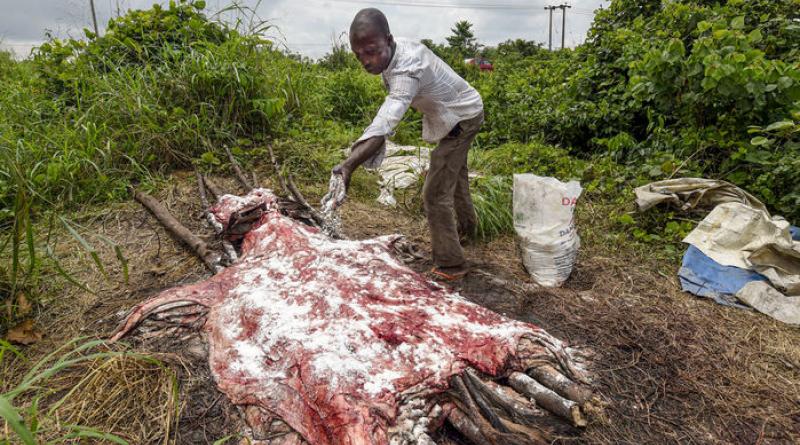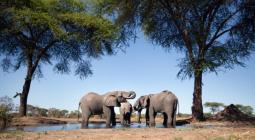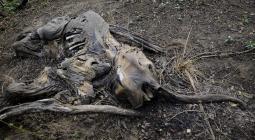Chinese trade in hides has led to global donkey massacre.

Amy McLean has always had a soft spot for long ears. The animal scientist at the University of California, Davis, grew up on a Georgia farm that bred donkeys and mules and has competed in mule riding world championships. Now, she studies donkey behavior and cognition, and she knows that despite popular negative stereotypes, donkeys are “highly intelligent and highly sensitive.”
No wonder she calls the current plight of the world’s donkeys “horrific.”
Over the past 6 years, Chinese traders have been buying the hides of millions of butchered donkeys (Equus asinus) from developing countries and shipping them to China, where they’re used to manufacture ejiao, a traditional Chinese medicine. The trade has led to an animal welfare nightmare, along with a threat to donkey populations, the severity of which is only now emerging. Without drastic measures, the number of donkeys worldwide will drop by half within 5 years, according to a 21 November report by the Donkey Sanctuary, an international equine welfare charity based in Sidmouth, U.K. The crisis threatens many of the world’s rarer donkey breeds and a vital means of transport for the poor. But it is also spurring new studies of donkey biology—including how to speed their reproduction.
Ejiao, in use for thousands of years, purportedly treats or prevents many problems, including miscarriage, circulatory issues, and premature aging, although no rigorous clinical trials support those claims. The preparation combines mineral-rich water from China’s Shandong province and collagen extracted from donkey hides, traditionally produced by boiling the skins in a 99-step process done at specific times of the year. Once reserved for China’s elites, ejiao is now marketed to the country’s booming middle class, causing demand to surge. One producer, Dong’e Ejiao in Liaocheng, China, touts it as “a creation of heaven and earth” that’s now passing “from the royal tribute to the home of ordinary people.”
Despite government incentives for new donkey farmers, farms in China can’t keep up with the exploding demand, which the Donkey Sanctuary currently estimates at 4.8 million hides per year. Donkeys’ gestation period is one full year, and they only reach their adult size after 2 years. So the industry has embarked on a frenzied hunt for donkeys elsewhere. (Importing hides is not illegal in China, and the import tax was lowered from 5% to 2% last year.) This has triggered steep population declines. In Brazil, the population dropped by 28% between 2007 and 2017, according to the new report.
African populations are crashing, too, says Philip Mshelia, an equine veterinarian and researcher at Ahmadu Bello University in Zaria, Nigeria. After buying donkeys at markets, traders often drive large herds to slaughter, sometimes covering hundreds of kilometers with no rest, food, or water. Those transported by truck fare worse: Handlers tie their legs together and sling them onto piles or strap them to the top of the truck, Mshelia says. Animals that survive the journey—many with broken or severed limbs, as well as other injuries—are unloaded by the ears and tails and tossed in front of a slaughterhouse. Some meet their end in an open field where humans await them with hammers, axes, and knives.
For donkey owners, selling their animal means quick cash—now more than $200 in parts of Africa—but it’s often a shortsighted deal: The report estimates that working donkeys support the livelihood of half a billion people by carrying people and goods to markets, schools, and health clinics. Losing donkeys means “the people become the donkey again,” McLean says. Women most often shoulder that burden.
Ironically, the booming ejiao trade, along with a developing donkey dairy industry in Eastern Europe, has stirred scientific interest in donkeys. The number of PubMed-indexed papers with “donkeys” in the title shot up from six in 2000 to 46 so far this year, for example, including many from China.
Zhen Shenming, a reproductive biologist at the China Agricultural University in Beijing, says Chinese efforts are focused on increasing yields, for instance through artificial insemination and harmonization of the estrus in female donkeys, which allows farmers to inseminate them more efficiently. “We’re improving techniques so jennies don’t end up empty,” Zhen says. Those improvements include better techniques to freeze and thaw sperm; for reasons that are unclear, breeding with cryopreserved semen is much less successful in donkeys than in horses. Zhen takesejiao himself occasionally for “better color” and “more energy,” although he says scientists “still don’t know the bioactivity of the product.”
"We need people to think of donkeys in terms of savings accounts."




